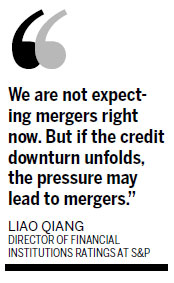Study predicts operating conditions will decline over next few years
China's banking system will have its resilience tested over the next three to five years as operating conditions turn harsher, which in turn may trigger a massive industry consolidation, Standard & Poor's Ratings Services said on Wednesday.
|
 |
|
Industrial and Commercial Bank of China Ltd's booth at the China Education Expo in Beijing on Saturday. An S&P study said that larger, stronger banks will have an opportunity to snap up smaller, weaker players if the economic slowdown worsens. [Photo/China Daily] |

As the industry faces an increasing number of corporate defaults and a narrowing net-interest margin because of the slowdown in the economy, the damage to banks' balance sheets is about to surface, according to S&P's latest study of China's 50 largest commercial banks by assets.
Smaller banks, which are aggressive but unprepared, will be hardest hit by the worsening conditions, resulting in a growing gap between the strongest and weakest banks in China. S&P said that the larger and stronger banks will see a good opportunity to snap up smaller and weaker players to strengthen their market positions.
"More and more small banks will choose to build alliances," said Liao Qiang, director of Financial Institutions Ratings at S&P.
"We are not expecting mergers right now. But if the credit downturn unfolds, the pressure may lead to mergers."
Chen Daofu, policy research chief of the Financial Research Institute at the State Council Development Research Center, said: "The credit scale has expanded rapidly in the past few years, but now its growth is thwarted and there is a rise in the number of non-performing loans."
"The market-oriented interest rate reform also puts a lot of pressure on banks," he added.
The slowdown of China's economic growth not only affects the country's banking industry, but also casts a shadow on top companies.
Although the sovereign credit rating for China remains strong, the credit profile of the leading companies is lagging, S&P said.
"The operating performance of these companies is a shining point. But the level of liabilities is relatively high, resulting in high financial risks," said Fu Bei, director of Corporate Ratings in Asia Pacific at S&P.
S&P concluded that the companies in the telecommunications, and oil and gas sectors rank the best in credit strength, with strong positions and minimal financial risks.
"The oil and gas sector enjoys structural advantages and increasing demand. The monopolistic status of the three big oil and gas companies will not be changed easily, and the government also has considerations for national energy security," said Lawrence Lu, director of Corporate Ratings in Asia Pacific at S&P.
By contrast, companies in the field of construction, engineering, coal and infrastructure are more aggressive and face higher risks.
The iron and steel industry and the aluminum industry also face great challenges. Overcapacity remains severe, and many products concentrate on the low end.
Lu said he expects the industry to be a low-profit one for a long time.
Chen at the State Council's Development Research Center, said: "It is important to encourage innovation and to drive the process of transformation. Companies need to further reduce costs, and there might be necessary integrations and restructuring in each sector."
S&P's study looked at 107 Chinese major companies across 15 industry sectors, among which about 80 percent were State-owned entities.
The study assessed the stand-alone credit profile of these companies.
Ye Yiwen contributed to this story.
weitian@chinadaily.com.cn
